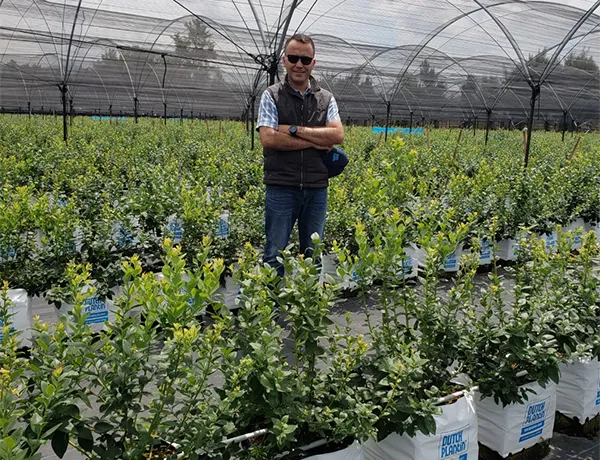“The blueberry cultivation is growing rapidly around the world, and together with it the demand for coco substrate”, Wim Roosen from Dutch Plantin says. Blueberry used to be an open field crop, but most of the new projects are using hydroponic growing techniques, offering new opportunities and of course new challenges.
Hectares of blueberry plants, all lined up nicely and all protected from weather circumstances by a foil greenhouse. It's a sight not unknown to Wim Roosen with Dutch Plantin. The hydroponic cultivation of blueberries is on the rise. "The demand from retail for a constant year round supply is one of the causes of the growth of the blueberry market", Wim says. "In addition thanks to new knowledge and varieties the hydroponc yields continue to grow, making an intensified cultivation more interesting. Also labour, which is still an issue, becomes more manageable thanks to new varieties with bigger fruits, increasing the yield per square meter. Picking 7-8 kilograms an hour instead of 4-5 kilograms results in a decrease in cost price, which makes it cheaper and therefore more interesting for supermarkets and consumers."

Hydroponic growing
Numbers show that the yield per square meter when growing hydroponically can be up to 5 times higher than the yield in open field production. "The average open field cultivation yield around the world is about 6 tonnes per hectare, for substrate that is 20 to 30 tonnes", Wim estimates, thus showing why many of the new blueberry cultivation companies chose to grow hydroponically.
“What we see, what our guy Julio in Mexico sees, is that there’s 5,500 hectares of blueberries there. It grows very rapidly and 80 percent of new growers choose to grow hydroponically. And this is just the beginning. Most of the Mexican growers work in the open field, but an increasing amount of new farmers works with a protected crop. Because of the higher yield, they want to have some sort of insurance by covering the crop with a screen or net. The irrigation solutions, the biological crop protection and even climate control solutions result in blueberries being grown more and more as a greenhouse crop. Blueberry used to be an extensive crop, but is becoming more and more intensive."

Intensifying
In the blueberry trends the rise of markets like Mexico is remarkable, as are countries like Peru and Columbia. "Where Chile is a big player in the blueberry market historically, we see that, just like in US and Canada, many growers prefer to add hectares when they want to achieve a higher yield, whereas growers in Mexico, Peru and Colombia chose to intensify the cultivation and harvest the same yield from a fraction of the acreage. These markets are in full swing." In addition he points at Morocco, also an important player for the export to the EU.
The growing blueberry market is of high relevance to Dutch Plantin, since more and more growers chose to grow on coco. A remarkable development, since it was believed before that the plants thrive best on a substrate with a low pH.
“Before it was believed that either peat or perlite had to be in the substrate or that the pH of the substrate had to be lowered by adding peatmoss. Nowadays growers see blueberries grow well on pure coco. This started in Mexico over a decade ago and the results are spreading all over the world." Growers are positive about it, yet to be sure Duth Plantin is doing a 5 year trial in Spain. "We want to know the exact results before we can say anything on whether growing on pure coco is better than a blend - but we now see that growers make this decision already. Of the new starting cultivation companies in Mexico, thirty percent now buys a blend with peat. Seventy percent buy pure coco."

Important in the choice of the substrate is the quality and the stability of the product, Wim adds, showing the Coco-10 mix they created of pith, fiber and chips to ensure optimum crop growth. "In the coco market in general there's a big distance between the suppliers that sell stable products of high quality, processed by trusthworthy machines and aged to get the preferred maturity and humidity. Then there's also a number of suppliers that opt for the fast route - but we hear from many growers those growing results are not what they expected, nor what they would like to see. The mix and the substrate preference can differ from grower to grower, but quality and stability is important no matter what."

Trends
The rise of coco can be an important trend, since there is a shortage on peat and a trend to step away from peat in general. "For the blueberries specifically we've seen that potting soil can be a good product - but only when the potting soil industry is near and affordable. Otherwise growers tend to look for a different type of substrate."
Yet, even though the global supply of coco is on the rise, even the coco suppliers might not be able to answer the rising demand for substrates.
“The demand for substrates will grow enormously in the thirty years to come, and in addition there's a trend to reduce the harvest and use of peat. We're now talking about Mexico as a growth market, but forecasts predict that the demand from China will affect the global market. In our opinion, different substrates will have to be used in those crops and those regions where they can serve the crop best,” Wim thinks.
"For example coco is usually best in the warmer regions, whereas stonewool can be the preferred solution in colder regions. This way it is possible to answer the growing demand all over the world."

